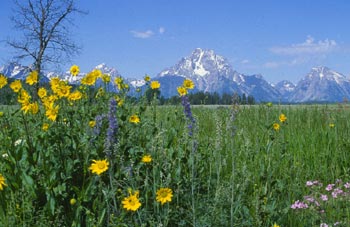- Home
- About S&T
- Taxa/Organisms
- Ecosystems
- Issues
- Methods & Tools
- Reports & Publications
- Location
- Search
Publisher: USGS | Science Center: Fort Collins Science Center (FORT, Ft. Collins) | Format: URL
www.fort.usgs.gov — USGS scientist Craig Allen, along with Tom Swetnam of the University of Arizona Laboratory of Tree-Ring Research, Scott Anderson of Northern Arizona University, and others, have been developing landscape-level fire histories in the Jemez and Sangre de Cristo Mountains of northern New Mexico. These histories are compiled using charcoal deposits More...

2008 | Publisher: USGS | Science Center: Fort Collins Science Center (FORT, Ft. Collins) | Format: URL
www.fort.usgs.gov — With the exception of Aspen, coniferous species dominate the forests of the Rocky Mountains (Populus tremuloides Michx.; Peet, 2000). The establishment of new aspen stands in the central Rocky Mountains generally follows major disturbances, particularly forest fires, with new stems sprouting from surviving root systems and with rare establishment More...

2007 | Publisher: Other (Ecological Society of America) | Format: .PDF
www.nrmsc.usgs.gov — Every winter, government agencies feed ;6000 metric tons (63 106 kg) of hay to elk in the southern Greater Yellowstone Ecosystem (GYE) to limit transmission of Brucella abortus, the causative agent of brucellosis, from elk to cattle. Supplemental feeding, however, is likely to increase the transmission of brucellosis in elk, and may be affected by More...

1999 | Publisher: USGS | Science Center: Fort Collins Science Center (FORT, Ft. Collins) | Format: URL
www.fort.usgs.gov — A quasi-experimental situation exists in Rocky Mountain National Park, where elk (Cervus elaphus) populations have increased 3-fold since 1968 following their release from artificial controls within the park. Increases in elk habitat use and decreases in deer habitat use were observed. Significant increases in cover of mosses and lichens occurred More...

Publisher: USGS | Science Center: Forest and Rangeland Ecosystem Science Center (FRESC, Corvallis) | Format: URL
fresc.usgs.gov — The Conservation Genetics Lab carries out molecular analysis, pedigree analysis, modeling, data management, and cryogenic sample repository. As a part of this research, the lab investigates the effectiveness of molecular markers used to enhance enforcement of the Endangered Species Act policy. During the past 15 years, this research has involved More...

Publisher: USGS | Science Center: Fort Collins Science Center (FORT, Ft. Collins) | Format: URL
www.fort.usgs.gov — This site is in part a hybridization of two of the most popular pre-existing sites about the wild horse research. Three research and development tasks are featured, which are counting wild horses and burros by combining and field-testing aerial survey techniques (this work assists the BLM in obtaining more accurate population estimates, on which More...

Publisher: USGS | Science Center: Northern Rocky Mountain Science Center (NRMSC, Bozeman) | Format: .PDF
www.nrmsc.usgs.gov — The ecology of hoofed big-game species in the northern Rocky Mountains, known as ungulates, is strongly influenced by climate. Climate change impacts summer precipitation, winter snow pack, and the timing of spring green-up, all of which control animal physiology, demography, diet, habitat selection, and predator prey interactions. However, the More...

Publisher: USGS | Science Center: Upper Midwest Environmental Sciences Center (UMESC, LaCrosse) | Format: URL
www.umesc.usgs.gov — The moose population in northwestern Minnesota has been declining for over 25 years. The U.S. Fish and Wildlife Service has identified a need to determine whether the moose decline is a result of nutrition, parasites, disease, contaminants, or a combination of those factors. In an attempt to determine the cause of death for moose in northwestern More...

Publisher: USGS | Science Center: National Wildlife Health Center (NWHC, Madison) | Format: URL
www.nwhc.usgs.gov — The ongoing pandemic of Foot-and-Mouth Disease (FMD) in Europe and other parts of the world is of great concern to the North American Agriculture Community. FMD may also pose a significant threat to North American wildlife, including white-tailed deer, other deer species, feral pigs, bison, moose, antelope, peccaries, musk ox, caribou, sheep and More...

Publisher: USGS | Science Center: National Wildlife Health Center (NWHC, Madison) | Format: URL
www.nwhc.usgs.gov — Chronic wasting disease (CWD) is a disease of the nervous system in deer and elk that results in distinctive brain lesions. It continues to be a major issue for wildlife scientists throughout the Nation, and a key focus for research at the USGS National Wildlife Health Center (NWHC). Research is focused on understanding how the disease is More...

Publisher: USGS | Science Center: Northern Rocky Mountain Science Center (NRMSC, Bozeman) | Format: URL
www.nrmsc.usgs.gov — A study overview related to the role of the National Bison Range in the long-term management of Federal bison herds. This research will provide the data necessary to assess the impacts of management actions implemented under the new management plan, and examine the plan`s underlying assumptions regarding demographic responses of the Yellowstone More...

Publisher: USGS | Science Center: Northern Rocky Mountain Science Center (NRMSC, Bozeman) | Format: URL
www.nrmsc.usgs.gov — To devise credible strategies for managing human-wildlife conflicts, managers need information about the importance of specific areas to particular species. In the Greater Yellowstone Area, for example, development of low-elevation areas seriously threatens vital ungulate winter ranges, with obvious implications for both ungulates and their More...
